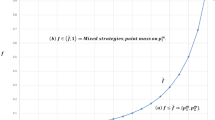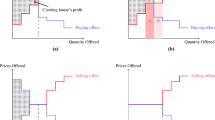Abstract
We report on experimental duopoly markets with heterogeneous goods. In these markets, sellers first choose capacities and then prices. While capacities remain fixed for either five or ten periods, prices have to be chosen in every period. The experiments starts with two sets of exogenously predetermined capacities. Independently of the distribution of capacities is, a unique pure-strategy in prices is subgame perfect. In equilibrium, capacities should correspond to the Cournot prediction. Given capacities, price-setting behavior is in general consistent with the theory. Average capacities converge above the Cournot level. Capacities converge at the industry level but are somewhat dispersed. Sellers rarely manage to cooperate.
Similar content being viewed by others
References
Boccard, N. and Wauthy, X. (2000). “Bertrand Competition and Cournot Outcomes: Further Results. ” Economics Letters. 68, 279–285.
Brown-Kruse, J., Rassenti, S., Reynolds, S., and Smith, V.L. (1994). “Bertrand-Edgeworth Competition in Exper-imental Markets. ” Econometrica. 62(2), 343–372.
Cournot, A. (1838). Recherches sur les principles math´ ematiques de la th´ eorie des richess. Paris: Hachette.
Davidson, C. and Deneckere, R. (1996). “Long-Run in Capacity, Short-Run Competition in Price, and the Cournot Model. ” RAND Journal of Economics. 17(3), 404–415.
Davis, D.D. (1999). “Advance Production and Cournot Outcomes: An Experimental Investigation. ” Journal of Economic Behavior and Organization. 40, 59–79.
Dufwenberg, M. and Gneezy, U. (2000). “Price Competition and Market Concentration: An Experimental Study. ” International Journal of Industrial Organization. 18, 7–22.
Fischbacher, U. (1999). “Z-Tree: Zurich Toolbox for Readymade Economic Experiments. ” Working Paper No. 21, Institute for Empirical Research in Economics, University of Zurich.
Güth, W. (1995). “A Simple Justification of Quantity Competition and the Cournot-Oligopoly Solution. ” ifo-Studien. 41(2), 245–257.
Güth, S. and Güth, W. (2001). “Preemtption in Capacity and Price Determination-AStudy of Endogenous Timing of Decisions for Homogenous Goods. ” Metroeconomica. 52(3), 329–355.
Huck, S., Normann, H.-T., and Oechssler, J. (1999). “Learning in Cournot Oligopoly-An Experiment. ” Economic Journal. 109, C80-C95.
Huck, S., Normann, H.-T., and Oechssler, J. (2000). “Does Information About Competitors' Actions Increase or Decrease Competition in Experimental Oligopoly Markets?” International Journal of Industrial Organization. 18, 39–58.
Huck, S., Normann, H.-T., and Oechssler, J. (2001). “Two are Few and Four are Many: Number Effects in Experimental Oligopolies. ” Mimeo: Humboldt-Universit¨ at zu Berlin. Forthcoming in: Journal of Economic Behavior and Organization.
Keser, C. (2000). “Cooperation in Symmetric Duopolies with Demand Inertia. ” International Journal of Industrial Organization. 18, 23–38.
Kreps, D. and Scheinkman, J. (1983). “Quantity Precommitment and Bertrand Competition Yield Cournot Out-comes. ” Bell Journal of Economics. 14, 326–337.
Maggi, G. (1996). “Strategic Trade Policies with Endogenous Mode of Competition. ” American Economic Review. 86, 237–258.
Martin, S. (1999). “Kreps and Scheinkman with Product Differentiation: An Expository Note. ” Mimeo: University of Amsterdam.
Martin, S. (2000). “Two-Stage Capacity Constrained Competition. ” Mimeo: University of Amsterdam.
Martin, S., Normann, H.T., and Snyder, C.M. (2001). “Vertical Foreclosure in Experimental Markets. ” RAND Journal of Economics. 32, 466–496.
Muren, A. (2000). “Quantity Precommitment in an Experimental Oligopoly. ” Journal of Economic Behavior and Organization. 41, 147–157.
Phlips, L. (1995). Competition Policy-A Game Theoretic Analysis. Cambridge: Cambridge University Press.
Rees, R. (1993). “Collusion in the Great Salt Duopoly. ” Economic Journal. 103, 833–848.
Rosenbaum, D.I. (1989). “An Empirical Test of the Effect of Excess Capacity in Price Setting, Capacity-Constraint Supergames. ” International Journal of Industrial Organization. 7, 231–241.
Selten R. (1994). “Multistage Game Models and Delay Supergames. ” In T. Fraengsmeyer (ed.), Les Prix Nobel 1994. Stockholm: Almquist & Wiksell, pp. 320–348.
Selten, R., Mitzkewitz, M., and Uhlich, G.R. (1997). “Duopoly Strategies Programmed by Experienced Players. ” Econometrica. 65, 517–556.
Selten, R. and Stoecker, R. (1986). “End Behavior in Finite Prisoner's Dilemma Supergames. ” Journal of Economic Behavior and Organization. 7, 47–70.
STATA Corp. (1999): Reference Manual, Release 6, STATA Press Texas.
Yin, X. and Ng, Y.-K. (1997). “Quantity Precommitment and Bertrand Competition Yield Cournot Outcomes: A Case with Product Differentiation. ” Australian Economic Review. 36, 14–22.
Author information
Authors and Affiliations
Rights and permissions
About this article
Cite this article
Anderhub, V., Güth, W., Kamecke, U. et al. Capacity Choices and Price Competition in Experimental Markets. Experimental Economics 6, 27–52 (2003). https://doi.org/10.1023/A:1024248608752
Issue Date:
DOI: https://doi.org/10.1023/A:1024248608752




